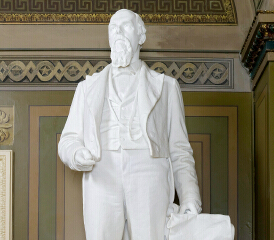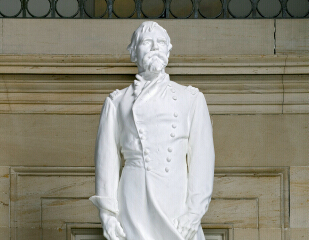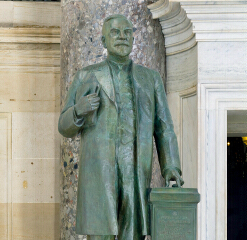|
Interesting Facts about the 31st Indiana
Statues in the U.S. Capitol of Men who were Leaders of the
31st Indiana:
The 31st Indiana Volunteer Infantry can claim 3 Statues as part of the
National Statuary Hall in the U.S. Capitol that were Leaders of the
31st Indiana. I am not sure of how many other regiments can
claim that many. We can also claim Abraham Lincoln and Ulysses
S. Grant whose statues are located in the Rotunda, that would make 5.
All Union regiments can claim Abraham Lincoln and most can claim
Ulysess S. Grant.
The below honored men had their statues given to the U.S. Capitol by
their States.
Most of the
Source Material comes directly from the
National Statuary Hall website. U.S. Capitol
#1. Oliver Perry
Morton, b.1823-d.1877. Governor of Indiana during the Civil
War. As governor, O. P. Morton was ultimately responsible for
the formation of the 31st Indiana and the appointment of officers for
the regiment. He insured that the 31st Indiana received its arms
and kept in communication with Colonel Charles Cruft significantly in 1861
and 1862.
Artist: Charles H. Niehaus. Medium: Marble. Given by
Indiana in 1900. Location: Senate wing, 1st Floor.
|
Biography: The
full name of this colorful governor of Indiana and United States
senator was Oliver Hazard Perry Throck Morton. He was born on
August 4, 1823. His mother died when he was three, and he went to
live with his maternal grandparents, from whom he received a
strict Scotch Presbyterian upbringing. He suffered a number of
financial reversals as a young man but was eventually able to
complete his law studies.
Morton's entry into
the political arena coincided with the inception of the Republican
party. He served as governor of Indiana for six years (1861-1867)
and was a loyal supporter of the Union's efforts during the Civil
War. He was a United States senator from 1867 to 1877. Morton
became a controversial figure with his attitude toward paper
money. He was considered "soft" because he favored issuing paper
money with no backing during difficult times. This view, combined
with his failing health, worked against his attaining the
Republican presidential nomination in 1867. He did, however,
participate as a member of the Electoral Commission appointed to
determine the outcome of that contested presidential election.
Oliver Morton died of
a stroke on November 1, 1877, while on a trip to Oregon
investigating charges of bribery made against a newly elected
senator from that state. Morton was a physically commanding
person, known for his devotion to party, his honesty and his
rhetoric. |

Oliver Perry Morton |
#2. Lewis (Lew)
Wallace, b. 1827- d. 1905. Led the 31st Indiana at its first
Battle at Fort Donelson. He led the 3rd Division of the District
of Cairo under U. S. Grant. The 31st Indiana was in the 1st
Brigade under Wallace's 3rd Division.
He is remembered for
his political accomplishments and for being one of America's most
noted authors.
Artist: Andrew O'Conner. Medium: Marble. Given by Indiana
in 1910. Location: National Statuary Hall.
|
Biography:
Lewis (Lew) Wallace was born in Brookville, Indiana, on April 10,
1827. An adventurous boy, he was often truant from school, but
when his father was elected governor of Indiana in 1837 Wallace's
interest in reading was stimulated by his new proximity to the
state library. He became a reporter for the Indianapolis Daily
Journal for one year, but when the Mexican War broke out he left
to raise a company of soldiers. After the war Wallace served as a
member of the Indiana state Senate from 1856 to 1860.
A general during the Civil War, he was distinguished as a leader
and fighter, and he was credited with saving Cincinnati from the
Confederate Army in September 1862. In July 1864, following his
defeat at the battle of Monocacy in Maryland, he slowed the
Confederate advance toward Washington, D.C., giving city time to
ready its defenses; Ulysses S. Grant later praised this delaying
action as ďa greater benefit to the cause than often falls to the
lot of a commander . . . to render by means of a victory.Ē Wallace
also served on the court-martial tribunal that tried the
accomplices of John Wilkes Booth, President Lincolnís assassin. He
was later governor of New Mexico Territory from 1878 to 1881 and
minister to Turkey from 1881 to 1885.
His book Ben Hur made him one of the most noted authors in
America. Over 300,000 copies were sold within 10 years of its
publication, and it continues to be a favorite adventure story.
During the last years of his life Wallace lectured extensively. He
died on February 15, 1905, at Crawfordsville, Indiana. |

Lew Wallace |
#3. William Henry
Harrison Beadle, b. 1838- d. 1915. Entered the U.S. Army as
a 1st Lieutenant in Co. "A", 31st Indiana Volunteer Infantry.
Was promoted to captain in November, 1861. He resigned February
9, 1862 to join
the 1st Michigan Volunteer Sharpshooters. He
was wounded in battle and later joined Veterans Reserve Corps (V.R.C.).
He was later brevetted Brigadier General by U. S. Grant.
Artist: H. Daniel Webster. Medium: Bronze. Given by South
Dakota in 1938. Location: National Statuary Hall.
|
Biography: William Henry Harrison
Beadle, born in a log cabin in Parke County, Indiana, on January
1, 1838, grew up on the frontier. Refusing his father's offer of a
farm, he accepted instead $1000 for an education. He studied civil
engineering at the University of Michigan. Shortly after
graduating in 1861, he enlisted in the Union Army [as a 1st
Lieutenant in Co. "A" 31st Indiana Volunteer Infantry, later
promoted to Captain of Co. "A".] and by the end of the war had
risen to the rank of brigadier general. He received his law degree
from the University of Michigan in 1867 and practiced briefly.
In 1869 President
Grant appointed him surveyor-general of Dakota Territory. His
journeys through the territory and his previous frontier
experience convinced him that school lands were a trust for future
generations and should be sold at their appraised value and never
for less than $10 an acre. This effort dominated his life. He
served as secretary of the 1877 commission to codify the
territorial laws and as chairman of the judiciary committee in the
territorial House. In 1879 he became superintendent of public
instruction. Beadle drafted the school lands provision at the
South Dakota constitutional convention of 1885. When Congress
accepted the state constitution in 1889, it was so impressed that
similar provisions were required for North Dakota, Montana,
Washington, Idaho and Wyoming. This preserved 22 million acres for
schools.
Beadle served as
president of the Madison State Normal School from 1889 to 1906,
and as a professor of history until his retirement in 1912. He
died on November 15, 1915, in San Francisco while visiting his
daughter.
|

William Henry Harrison Beadle |
|